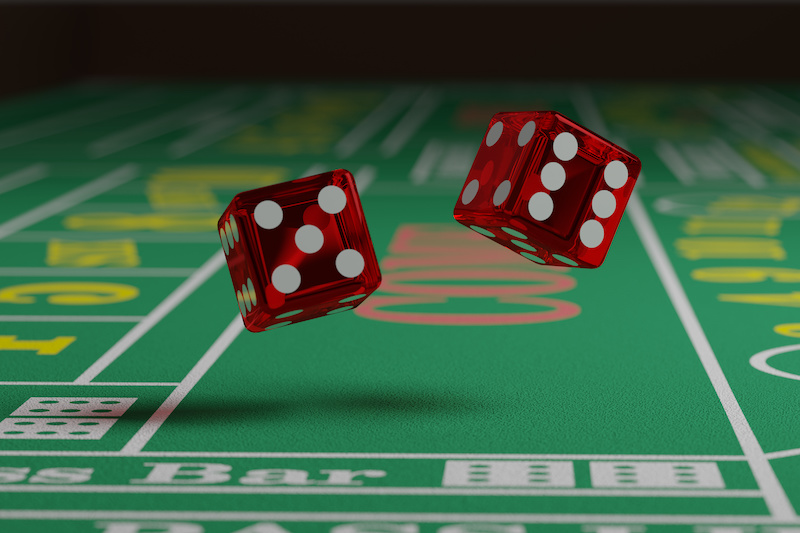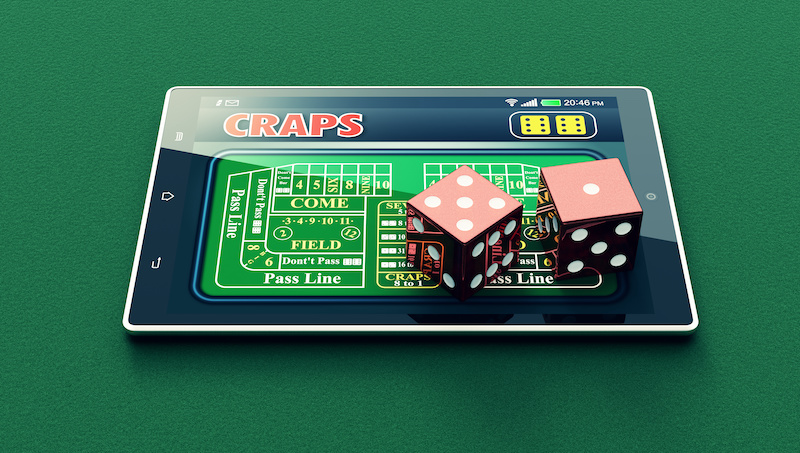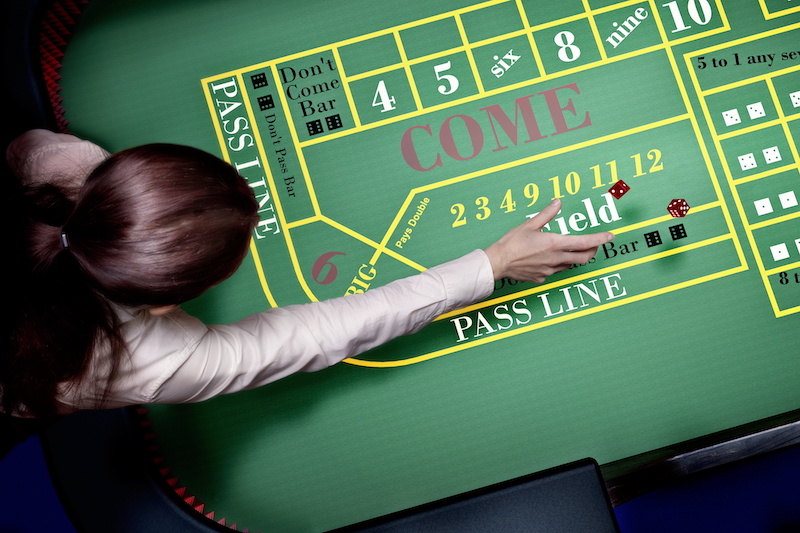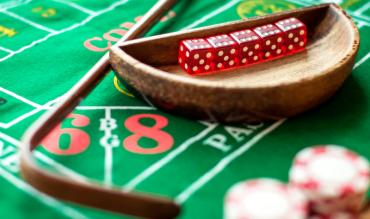Craps is one of the most exciting and player-friendly games you can bet on in both land-based and online casinos. All you need to know about the game is explained in this beginner craps strategy guide.
WHAT IS THE BEST STRATEGY FOR CRAPS?
Our expert writer, John Grochowski is going to teach you how to win at craps strategy and how to shoot dice in the best possible way.
WHAT THE BEST CRAPS STRATEGY CAN ACHIEVE
The game of craps is popular because the house edge on some bets is low. If you use the best craps strategy—and luck is on your side—a streak of wins at a hot table can generate a growing chip stack and a strong sense of camaraderie among players and onlookers.
Following winning rolls of the dice, loud cheers radiate around the craps table and offers of high fives are plentiful. But you can still have fun if you play on a bubble machine online using a bubble craps strategy. And this ultimate craps strategy guide will explain how.
WHY WE PUBLISHED THIS CRAPS BETTING STRATEGY GUIDE
Just a little explanation can eliminate any confusion and start you off with the best craps strategy guide knowledge to better understand the game.
- Craps has both some of the best bets in the casino and some of the worst.
- And rules on how craps bets are settled can be confusing for new players to understand—especially bets that take more than one roll to settle.
This craps strategy guide will explain how craps bets are made and settled so you can enjoy one of the most exciting casino games. Topics covered in this guide include the following:
- the best wagers in craps and the ones to avoid;
- the different types of craps strategy bets;
- betting with or against the shooter;
- how you can choose your own numbers or have a roll of the dice determine the number that could make you a winner on subsequent rolls.
WHO WROTE THIS CRAPS STRATEGY GUIDE?
John Grochowski wrote this craps strategy guide. Grochowski is one of the most widely published and respected authors on casino games and is a professional craps player. This expert craps strategy guide includes, how to play craps and the best craps betting strategy tips.
HOW IS CRAPS PLAYED?
Modern Craps is played with two six-sided deuce, and there are dozens of craps strategy bets available.
ONLINE CRAPS – TO PRACTICE YOUR CRAPS BETTING STRATEGY
Craps in online casinos offers some of the best odds around. If you’re looking for a shot to win, Craps is a prime-time game especially when using the right craps betting strategy.
BEST CRAPS STRATEGY - HOW TO PLAY CRAPS
So, what is Craps?
Craps can be as simple as:
- betting on one number and either winning or losing on each roll; or;
- as complex as making a bet, waiting until the shooter rolls a target; or;
- “point” number, then hoping the shooter can roll the same number again. That procedure can go on for any number of rolls.
The first chapter of the Ultimate Craps Strategy Guide is all about the basics of the game. You will be able to learn the following:
- the rules of craps;
- types of bets while playing at the craps table;
- house edge and the odds at the game of craps.
You’ll begin to see that the best craps strategy is learning all the rules of craps and ways to play the game.
HOW TO WIN AT CRAPS
Let’s be out-front with this: Every craps bet except the free odds/lay odds has a house edge, and there’s nothing most players can do to reverse the math.
A small number of dice controllers may be able to decrease the frequency of sevens and increase the frequency of point numbers enough to change the odds of craps games in their favor.
However, using a craps betting strategy that includes dice control is a physical skill that demands hours upon hours of practice. And even the most devoted controlled shooter will tell you the skill sometimes deserts them with changing physical conditions, fatigue or just whether they can find their rhythm that day.

CRAPS STRATEGY OF HOW TO SHOOT DICE
Most craps players want to shoot dice when they get the chance. Shooting gives you a sense of control over the game.
Your rolls determine whether everyone wins or loses. When you're on a hot roll of the dice that's making money for nearly everyone at the table, you're a hero and every move is cheered. There's no better feeling for a craps player.
But when the dice turn cold and the inevitable loss comes, there's no time to dwell on it. A new shooter steps up to take the dice in their hand to try and turn things around. And maybe a craps strategy of skill or wishing for luck or maybe a bit of both could hold the secrets of success.
CRAPS STRATEGIES – THE BEST CRAP STRATEGY BEGINS WITH KNOWLEDGE
Before starting to play craps, every craps player should have a plan of attack. That plan must consider a number of things, such as which craps strategy are you going to play.
If you read on, you’ll get to know about:
- the craps lay bet;
- hop bets;
- the iron cross; and;
- more about the most popular craps strategy, such as the risks associated with some of the methods; and;
- the odds in craps betting and how your bankroll plays a vital role in your craps betting strategy.
CRAPS STRATEGIES – HOW TO PLAN A CRAPS BETTING STRATEGY
For the best chances of winning at craps think about forming a craps betting strategy. Below I have listed the things you need to plan for when trying to form the best craps strategy.
CRAPS BANKROLL MANAGEMENT
- How much bankroll are you willing to risk in a session?
- Can you afford the craps money management method that offers the best odds?
- Long or short craps betting strategy?
Your craps betting goal will depend on answering the following questions:
- Do you want a lengthy playing session in hopes of grinding out a profit? Or;
- Do you intend to bet on higher paying odds, hoping for a quick win while understanding that when the long shots don't hit, you'll lose more money faster than with other methods?
- Are you willing to cross over to the dark side and bet against the craps shooter? The odds are a little better for don't players, but most players prefer the win-together camaraderie of betting with the shooter.
Let's look at some strategic plans of attack used by craps players. For details on how each individual bet works, please check earlier chapters in the ultimate craps strategy guide.
POPULAR CRAPS STRATEGIES
CRAPS STRATEGY USING THE PASS AND COME — WITH ODDS
The pass line is one of the most common craps bets and a great start to any craps strategy because it's a low house edge of 1.41 percent. It's even better with free odds, with the house edge decreasing depending on how many times your pass bet you then wager on odds.
If you play online electronic bubble craps and use a bubble craps strategy you could take advantage to low house edges.
A clever craps betting strategy could be to use the pass-plus-odds combination, the house edge declines to the following percentages:
- 0.8 percent with single odds;
- 0.6 percent with 2x odds;
- 0.4 percent with 3x, 4x, 5x odds;
- 0.3 percent with 5x odds;
- 0.2 percent with 10x odds; and;
- 0.02 percent at those rare casinos that offer 100x odds.
The house edges are exactly the same with come plus odds - 1.41 percent for starters, then the edge on the combo declining as your odds bet rises.
That's as it must be, for — as described earlier in this guide — the come bet is the same as the pass bet, except that it's made at a different point in the betting sequence.
If the shooter has not yet established a point on the pass line, then the next roll is a come-out, and you should bet on pass. If there's already a pass line point, then you can bet on come to get an additional number working.
Players who use this strategy frequently follow their pass bet with either two or three come bets—to get up to three or four numbers working.
How much should you bet on the odds? That's between you and your bankroll. If the casino offers 100x odds, you don't have to bet the full 100x. You can bet single odds, double odds—any amount in your monetary comfort zone that forms the best craps strategy for you.
The object of this craps betting strategy is to put as big a percentage of your bet as possible in the free odds, which have no house edge. Great for a bubble craps strategy, start with the table's minimum bet on pass or come, then reach your desired total wager by putting the rest in odds.
But betting more than you can afford is hazardous to your financial health, no matter how low the edge. You may think you have the best craps strategy, but you should focus on protecting your bankroll.

CRAPS BETTING STRATEGY TIPS:
THE UPSIDE: Betting pass and come with odds has the lowest house edge of any craps strategy that has you betting with the shooter.
THE DOWNSIDE: Having multiple numbers, all with odds, working at the same time puts a lot of money at risk at once.
CRAPS STRATEGY USING DON'T PASS AND DON'T COME WHILE LAYING ODDS
As detailed earlier in this craps strategy guide, don't pass and don't come are essentially the opposite of pass and come, You're betting against the shooter making his point.
The house edge of 1.36 percent on don't pass or don't come is a little better than the 1.41 percent on pass or come. Edges on don't pass or don't come when laying the odds decline to:
- 0.7 percent with single odds;
- 0.5 percent with 2x;
- 0.3 percent with 3x, 4x, 5x;
- 0.2 percent with 5x;
- 0.1 percent with 10x; and;
- 0.01 percent with 100x.
Just as with pass and come plus odds, the object of a good craps betting strategy is to put as big a percentage of your bet into the odds as possible — the odds have no house edge, and your don't pass and don't come bets do!
If you focus on bubble craps strategy online, you can take advantage of the low house edges and zero house edge bets.
So, the best craps strategy is to bet table minimums at don't pass and don't come, then reaching your desired total wager by laying the odds.
CRAPS BETTING STRATEGY TIPS:
THE UPSIDE: Don't pass and don't come while laying the odds give you the lowest house edge in craps.
THE DOWNSIDE: As with pass and come plus odds, total wagers can get pretty large, even if you start with minimum bets. Let your bankroll be your guide as to whether you can afford to follow your don't pass bet with don't come bets, and whether you can afford to lay the odds.
CRAPS STRATEGY OF PLACING 6 AND 8
This craps strategy is popular because craps players get to pick their own numbers, instead of waiting for the shooter to establish a point.
Other than 7, the 6 and 8 are the most frequently rolled numbers, so those are the numbers players like to have working. The house edge on placing 6 and 8 is 1.52 percent—higher than on pass, come, don't pass and don't come, but still lower than most bets in the casino!
Players in the know stay away from other place bets because the house edge is higher—4 percent on 5 or 9 and 6.67 percent on 4 or 10.
TOP PLACING 6 AND 8 CRAPS BETTING STRATEGY PAYOUT TIP:
If you're going to place 6 or 8, be sure to bet in multiples of $6. Winning bets are paid at 7-6 odds, but if you don't bet in multiples of $6, you'll get shorter pays. For example, a $5 bet will be paid only $5, but a $6 bet will be paid $7.
PLACING 6 AND 8 CRAPS BETTING STRATEGY TIPS:
THE UPSIDE: You're never stuck with less frequently rolled points such as 4 or 10, and you get a relatively low house edge.
Also, you can play this system for less money than the systems that include odds. At a $5 minimum table, placing both 6 and 8 requires an investment of only $12 at a time.
THE DOWNSIDE: No free odds are offered on point numbers and free odds have no house edge. The house edge is higher than on the pass-come-odds and the don't pass-don't come-lay odds systems.
PASS WITH ODDS CRAPS STRATEGY PLUS PLACE 6 AND/OR 8
Players who want to take advantage of free odds but can't afford to use it on both pass plus a series of come bets sometimes use this hybrid system.
You start with a pass line bet at table minimum. When a point is established, you back the pass bet with the free odds you can afford.
If the point is 6 or 8, then you add a place bet on the other number.
If the point is any other number, then you add place bets on both 6 and 8.
CRAPS BETTING STRATEGY TIPS:
THE UPSIDE: The house edge is lower than just placing 6 and 8 because of the free odds backing your pass bet.
You also always have the two most frequent non-7s working.
Just as important, it takes less money than the full pass-come-odds system. If you have a $5 pass bet backed with $10 in double odds, and you also have $6 place bets on both 6 and 8, your total at risk is $27. Contrast that with the $45 for pass and two come bets, all backed with double odds, and even more at risk if you bet more than double odds.
THE DOWNSIDE: You're not getting the lowest possible house edge, since the edge on the two place bets is higher than on the come-plus-odds combo in the first system listed here.

ALTERNATIVE CRAPS SYSTEMS
The strategies listed above are popular for a reason. They trim the house edge nearly to the bone and give you the best chance at extended play and winning sessions at craps.
However, there are alternative strategies. Some are designed for quick, big wins when they work. One way or another, you're in and out of action fast, either with your desired win or without the money you've budgeted.
Other ways of betting on craps are designed for players who want to bet the, don't side without sticking to, don't pass or don't come, or who want to find a way to take advantage of free odds without waiting for the shooter to establish a point. And some are designed for players trying to cover weaknesses in one bet by layering on another.
All of these have higher house edges than the craps systems already listed, so be warned—Proceed at your own risk.
CRAPS BETTING STRATEGY ON PUT BETS
Here's where you can take advantage of free odds without waiting for the shooter to establish a point.
Craps put bets, are pass line bets, made after the shooter already has established a point. If the shooter rolls a 6 on the come-out, you can still bet on the pass line. You get the 6 as your point and winners are paid even-money.
House edges are high:
- 9.1 percent if the point is 6 or 8;
- 20 percent if the point is 5 or 9; or;
- 33.3 percent if the point is 4 or 10.
That's because you're skipping the come-out, where there are:
- Eight ways to win, (six ways to roll 7 and two ways to roll 11); and;
- Only four ways to lose, (two ways to roll 3, one way to roll 2 and one way to roll 12).
As a craps strategy the attraction is that you can back your put bet with free odds, which in themselves have no house edge. If you play this bubble craps strategy online and get lucky you could be on a winning roll.
If you're a low roller, that's not enough incentive to make put bets. Most players who want to choose 6 or 8 as their goals are better off making place bets.
However, there are breaking points where put bets become as good as and better than place bets.
On points of 6 or 8, a put bet has the same, 1.52 percent house edge as a place bet, if you take 5x odds, and the house edge dips lower, if you wager even more in odds. If you take 4x odds, then other put bets have the same house edge as place bets — 4 percent on 5 or 9 and 6.67 percent on 4 or 10. Again, with more odds, the edge on the put-odds combination dips lower.
So, if you are sufficiently bankrolled and comfortable with betting 5x odds, then put bets on 6 or 8 become as good as placing 6 and 8. With 6x odds or more, put-plus-odds is better than the 6-8 place bets.
CRAPS BETTING STRATEGY TIPS FOR PUT BETS:
THE UPSIDE: You get to choose the most frequently rolled numbers, and you get to bring down the house edge by betting free odds.
THE DOWNSIDE: Bets will fall outside the comfort zone for many players. At a table with a $5 minimum bet, a $5 put bet plus 6x odds to drop the house edge on 6 or 8 below 1.52 percent means a $35 investment—and that's with only one number working. At the same table, you could get 1.52 percent by betting $6 on 6 or 8. So this is a craps system for bigger bettors.
One other thing. The house edge will never fall as low as pass plus the same amount of odds. You get to choose your points, but there's a cost in starting with a 9.1 percent put bet instead of a 1.41 percent pass bet.
HEDGE BETS CRAPS STRATEGY
Every craps bet has a weakness. On pass and come, it's that once a point is established, the most frequently rolled number, 7, is a loser. Same deal on place bets: 7 loses, and remember, that's the number that rolls most often.
Players sometimes try to cover the weakness with craps hedge bets. One common way to hedge is to bet on any 7 at the same time as making a place bet.
But you can lose multiple hedge bets and still lose your place bet.
Hedge bets are weaker than the weaknesses they're trying to cover. Betting systems that use hedges should be avoided.
CRAPS BETTING STRATEGY TIPS FOR HEDGE BETS
THE UPSIDE: Hedge bets can turn losing numbers into winners, giving you a profit when your main bet loses.
THE DOWNSIDE: House edges on hedge bets are very high. The bets themselves are of the one-roll variety, so there will be rolls when you lose your hedge bet while the outcome your main bet has still not been decided.
Overall, hedge bets in craps don’t work in favor of the player’s quest for profits.
CRAPS STRATEGY FOR IRON CROSS BETS
Sometimes called "the dinner bet" or "Darby's field," the Craps Iron Cross was designed as a hit-and-run strategy.
The idea is to cover many numbers, look for a win on your first roll, then take the remaining bets down, take your profit and move on. That "move on" portion is why some have called this the dinner bet. You leave after one win buys your dinner.
Iron Cross bettors cover every number except 7. They start with a field bet, which covers 2, 3, 4, 9, 10, 11 and 12. Then they also make, place bets on 5, 6 and 8.
Of the 36 possible combinations using two dice, that leaves 30 winners, with only the six ways to make 7 as losers.
IRON CROSS CRAPS BETTING PAYOUT ODDS TIP
Most field numbers pay even-money, but 2 usually pays 2-1 and 12 pays either 2-1 or 3-1. You want to find a table that pays 3-1 on 12 to take best advantage of this bet.
The place bet on 5 pays 7-5 odds, and the 6 and 8 pay 7-6 odds.
If you're betting minimums at a $5 table, the total investment is $22—$5 each on the field and the place bet on 5, and $6 each on the place bets on 6 and 8.
If the next roll is 12, you win $15. If it's 2, you win $10. You win $7 on 5, 6 or 8, and $5 on 3, 4, 9, 10 or 11.
If the roll is 7, you lose the full $22.
A $5 win won't buy dinner anymore, even at a casino buffet. It might be more like coffee and a doughnut…if you’re lucky. Still, the idea of this craps betting strategy is to win once and walk away.
CRAPS BETTING STRATEGY TIPS FOR IRON CROSS BETS
THE UPSIDE: You win on 30 of 36 rolls.
THE DOWNSIDE: Any loss is much larger than any of the wins, and the overall house edge—assuming all bets are decided—is 2.4 percent. That's not horrible, but it's not good enough for extended play when things like pass, come, free odds and the better place bets are around.

CRAPS STRATEGY FOR LAY BETS
Just as place bets enable you to choose your number instead of going through a come-out roll when betting with the shooter, craps lay bets enable don't bettors to choose the numbers they want to bet against.
If you want to bet against the least frequently rolled points — 4 and 10 — you can tell the dealer "lay the 4" or "lay the 10." Then you win if the shooter rolls a 7 before that number and lose if the lay number comes first.
Because 7s are rolled more frequently than the lay numbers — 4, 5, 6, 8, 9 or 10 — you must pay the house a 5 percent commission to make these bets.
Payoffs are at true odds. You bet $6 to win $5 on 6 or 8, multiples of $3 to win multiples of $2 on 5 or 9 or multiples of $2 to win $1 on 4 or 10. The house gets its edge by charging the commission.
The lowest house edge, 2.44 percent is on laying 4 or 10, while edges are 3.23 percent on 5 or 9 and 4 percent on 6 or 8.
So, the best craps strategy for players seeking the lowest edge is to lay 4 or 10.
CRAPS STRATEGY TIPS FOR LAY BETS
THE UPSIDE: You can choose the least frequently rolled point numbers, where don't bettors win more often, without going through a come-out roll.
THE DOWNSIDE: The house edge is higher on lay bets than on don't pass, don't come and lay odds. A 2.44 percent house edge on 4 or 10 is no match for the less than 1 percent edge on the bets where you can lay odds.
DON'T PASS WITH LAY ODDS, PLUS LAY 4 OR 10 CRAPS STRATEGY
This works just like the strategy listed earlier where those with the shooter bet pass plus odds, then place 6 or 8.
Start with a table minimum bet on don't pass. After the shooter establishes a point, lay odds on the point. If the point is 4, then also lay the 10. If the point is 10, then also lay the 4. If the point is any other number, lay both.
CRAPS BETTING STRATEGY TIPS FOR DON'T PASS WITH LAY ODDS, PLUS LAY 4 OR 10
THE UPSIDE: You get the chance to lay odds on your don't pass bet, and there is no house edge on laying odds. On the follow-up bets on 4 and/or 10, you can't lay odds, but that keeps your overall wager down.
THE DOWNSIDE: The house edge on lay bets is higher than on don't come, even more so when you also lay odds. Also, you're betting against the shooter, so you don't have the win-together feeling the majority of craps players like.
WHAT IS THE BEST CRAPS STRATEGY?
So, when it comes to craps games are there any craps strategy secrets and which what is the best craps strategy? That depends on your bankroll and preferences.
The lowest house edges and the best shot at winning craps sessions are pass-come-odds and don't pass-don't come-lay odds. If you can't afford the odds, then placing 6 and 8 gives you a shot to win while keeping wagers low.
You can choose the craps strategy that fits your goals, but keep in mind that straying from the best bets in craps exposes you to higher house edges.
*** This article has been reviewed and updated by Stephen Tabone – a professional and experienced casino player in the field.


